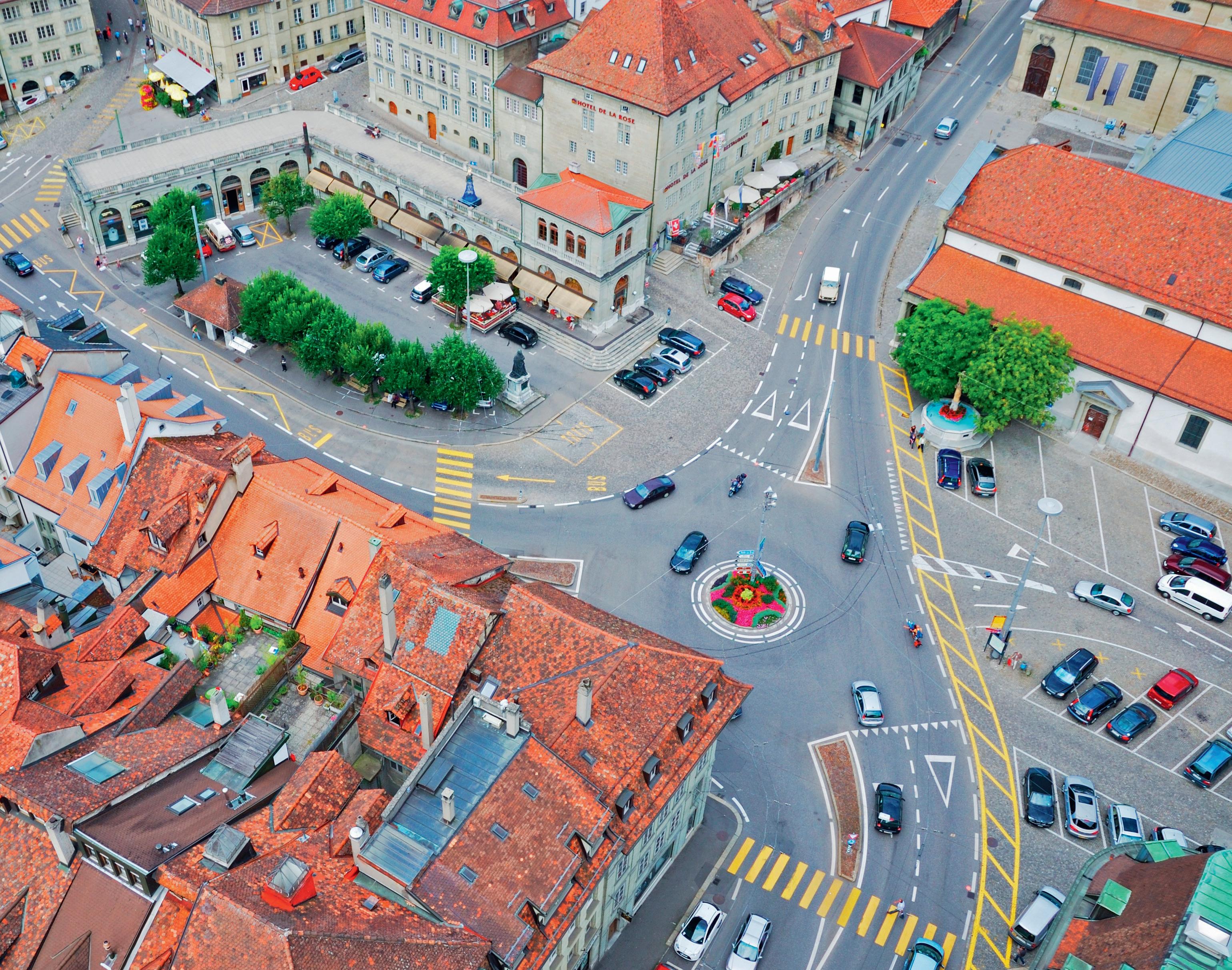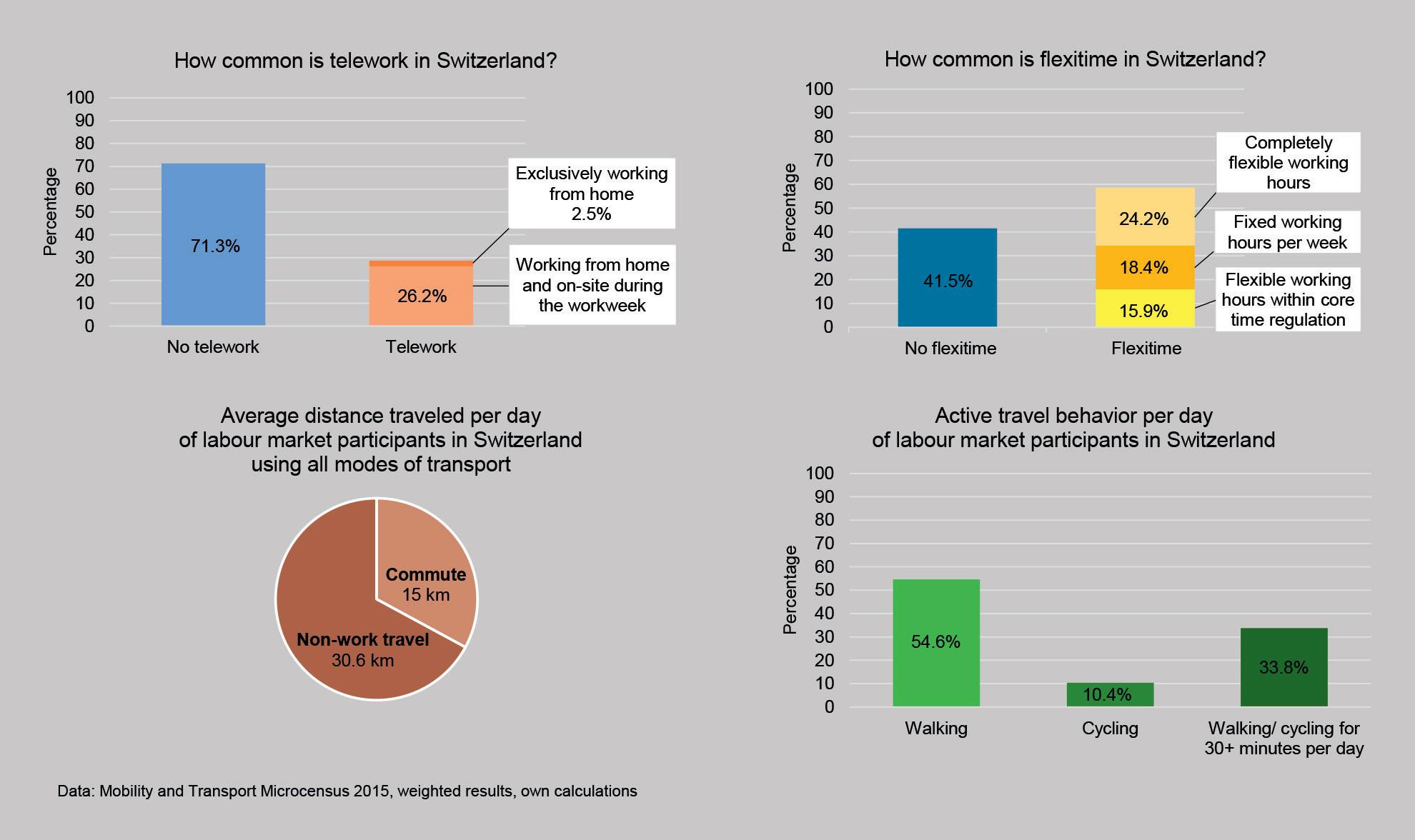Does working from home contribute to traffic reductions?
The mobility sector in Switzerland causes 32 percent of the country’s CO2 emissions. Hence, reductions or changes of the mobility sector are necessary to mitigate climate change. In their research, Dr Axel Franzen and Fabienne Woehner are investigating how digitalizing the labour market could help transform the mobility sector.
Switzerland has committed itself to the Paris Climate Agreement of 2015 which aims to limit the average global temperature increase to 1.5 or 2 degrees by the end of this century. For this purpose, Switzerland needs to reduce its greenhouse gas (GHG) emissions. Since the transport sector contributes substantially to emission levels, reductions in trafficand particularly in motorized transport - can contribute to Switzerland reaching the goals set out in the Paris Agreement. Additionally, Switzerland’s mobility sector suffers from traffic congestion. In 2019 the Swiss Federal Roads Office reported 30,000 traffic jam hours which are mainly due to road capacity overloads. Traffic congestion causes substantial time loss and economic costs. They occur especially during the morning and evening rush hours. Much of the country’s traffic is caused by commuters. Overall, 3.5 million people commute to the work place every day, and 50 percent of them do so by private cars.
Thus, next to reducing traffic and CO2 emissions, the transport sector also needs to redirect traffic and reduce usage during peak periods.
The digitalization of the labour market increasingly allows the usage of flexible forms of work. Flexibility is driven by the continuing diffusion of e-mails usage, online conferencing, virtual private networks (VPN), or digital files. These digital innovations allow telework and job flexibility. Telework means that part of the work is executed from home with the help of computers. Another kind of job flexibility applies to the working schedule and is called flexitime. Flexitime refers to the possibility to decide when to start and end the workday. Both flexible forms of work have the potential to reduce private mobility and also to reduce traffic during peak periods. First, working remotely could eliminate commuting on a regular basis, which might reduce traffic overall. Second, flexitime could help to distribute the traffic more evenly during the
day. This could be an important factor in reducing the need to expand the transport infrastructure. Therefore, the digitalization of the labour market has the potential to benefit the environment and the economy. However, it is not clear whether telework actually leads to less travel in general, or if saved commutes are counteracted by other trips (rebound-effect). It is also possible that working remotely could have other consequences, for instance, that people move further away from the workplace, which would lengthen the commute when they do need to be on-site. Flexitime workers could use their flexibility to commute outside of peak periods. However, they might also conform to common work hours of family members, friends, and colleagues, and hence, commute during rush hours. Therefore, the consequences of the digitalization of the labour market are not theoretically determined. Instead the way people react to the digitalization is an empirical question.
The project
The aim of the project is to investigate how working flexibly affects various aspects of travel behaviour. To answer these questions, we use the Swiss Mobility and Transport Microcensus (MTMC) 2015. This telephone survey is conducted approximately every five years by the Swiss Federal Statistical Office and the Office for Spatial Development. The MTMC is a nationwide representative survey consisting of 57,000 interviews. It contains abundant information about participants mobility behaviour, as well as other important variables such as the number of cars in a household, education of respondents, and their working arrangements. All our analyses refer to labour market participants between the ages of 18 and 65. Overall, labour market participants commute on average 15 kilometres per day. Teleworkers commute about 21 percent kilometres less than those who never telework. This is interesting as teleworkers could also combine remote work with work on-site on a given day, which would then not replace the commute. However, there is a rebound effect in non-work travel (e.g. trips for leisure or shopping). Teleworkers drive more for other reasons, such as shopping or leisure, as compared to on-site workers. Taken together, telework does not

hours. A possible explanation is that the decision to commute during morning peak periods is due to coordinating commuting times with other family members, friends, and colleagues.
Despite these findings, telework and flexitime still might be beneficial for the economy and particularly for public health if they are associated with more walking and cycling (active travel).
Previous research suggests that daily needs, such as shopping, are more likely to be executed closer to home when working remotely. Thus, these smaller distances can more easily be covered on foot or by bike. Moreover, flexitime lowers time constraints, which facilitates the use of slower modes of transport and might also offer additional opportunities to walk and cycle during breaks. Our analysis of the MTMC 2015 shows Swiss labour market participants walk on average 25 minutes per day, and cycle 6 minutes. Flexitime correlates with more and longer active travel, which is essentially due to more walking. The World Health Organization recommends about 30+ minutes of physical activity to entail some health benefits. Our statistical analyses show that teleworkers and flexitime users (those who have a core time agreement) are more likely to walk and cycle 30+ minutes per day.
Teleworkers who work partly at home commute to the workplace less often. However, the reduction in commutes is counteracted by trips for other purposes such as shopping or leisure. Overall, teleworkers do not travel less as compared to individuals who always work on-site.
affect the total distances travelled during a week. This applies to the total amount of kilometres travelled incorporating all modes of transport as well as distances only driven by private vehicles, such as cars or motorcycles. Even though telework does not reduce traffic, it might help to distribute the traffic more evenly during the day. Our results show that telework reduces evening rush hour commutes since teleworkers are less likely to commute by car during evening peak periods as compared to on-site workers. One interpretation of this finding is that teleworkers prefer to spend the afternoons working at home. In contrast to this, the analyses indicate that flexitime even promotes morning peaks as flexitime workers are more likely to commute to work during the morning rush
To sum up, this project contributes to the research about the impact of telework and flexitime on travel behaviour. The main conclusion of our study is that the digitalization of the labour market has not contributed to a reduction of traffic in Switzerland so far. However, the digitalization might increase slow traffic, and thereby improve public health. Our findings are based on surveys about individual behaviour. The results help to assess the consequences of the digitalization of the labour market, and provides some valuable insights on how to increase sustainability in the transport sector. Most likely, the digitalization of the labour market itself will not reduce traffic but must be combined with other measures such as congestion fees or road pricing.
MObiliT y in SWiT zerl An D:
Mobility in Switzerland: Potentials of the Digitalization of the labour Market for environment and economy

Project Objectives
The digitalization of the labor market increasingly allows working flexibly, e.g. working from home instead of the workplace, and being flexible with respect to working hours. Therefore, more and more employees could reduce commuting to the workplace or could avoid rush hours. However, the commuting time saved might be spent on trips elsewhere. Based on nationwide behavioral mobility data, the aim of this project is to investigate whether working flexibly actually contributes to reductions in traffic and helps to relieve traffic congestions at peak periods in Switzerland.
Project Funding
The project has received funding from the Swiss National Science Foundation (SNSF) under the grant number 188866. Furthermore, the Swiss Federal Statistical Office and the Swiss Federal Office for Spatial Development supported the study by providing the data.
Contact Details
Project Coordinator: Professor Dr. Axel Franzen

Project Staff: Fabienne Wöhner

University of Bern, Institute of Sociology, Switzerland

T: +41 31 684 48 74
e: axel.franzen@unibe.ch e: fabienne.woehner@unibe.ch

W: https://www.soz.unibe.ch/about_us/ people/prof_dr_franzen_axel/index_eng.html
W: https://doi.org/10.1016/j. jtrangeo.2022.103390
Axel Franzen is Professor for Methods and Statistics at the Institute of Sociology at the University of Bern, Switzerland. His research interests include methods of quantitative social research, experimental game theory and environmental sociology. He is an expert in empirically studying people’s mobility behaviour, and he has published various research on the discrepancy between environmental attitudes and pro-environmental behaviour.
Fabienne Wöhner is a PhD candidate in the Institute of Sociology at the University of Bern, Switzerland. The mobility project is part of her dissertation. Her research interests include survey methodology and data collection, environmental sociology, public health, and mobility behaviour.
